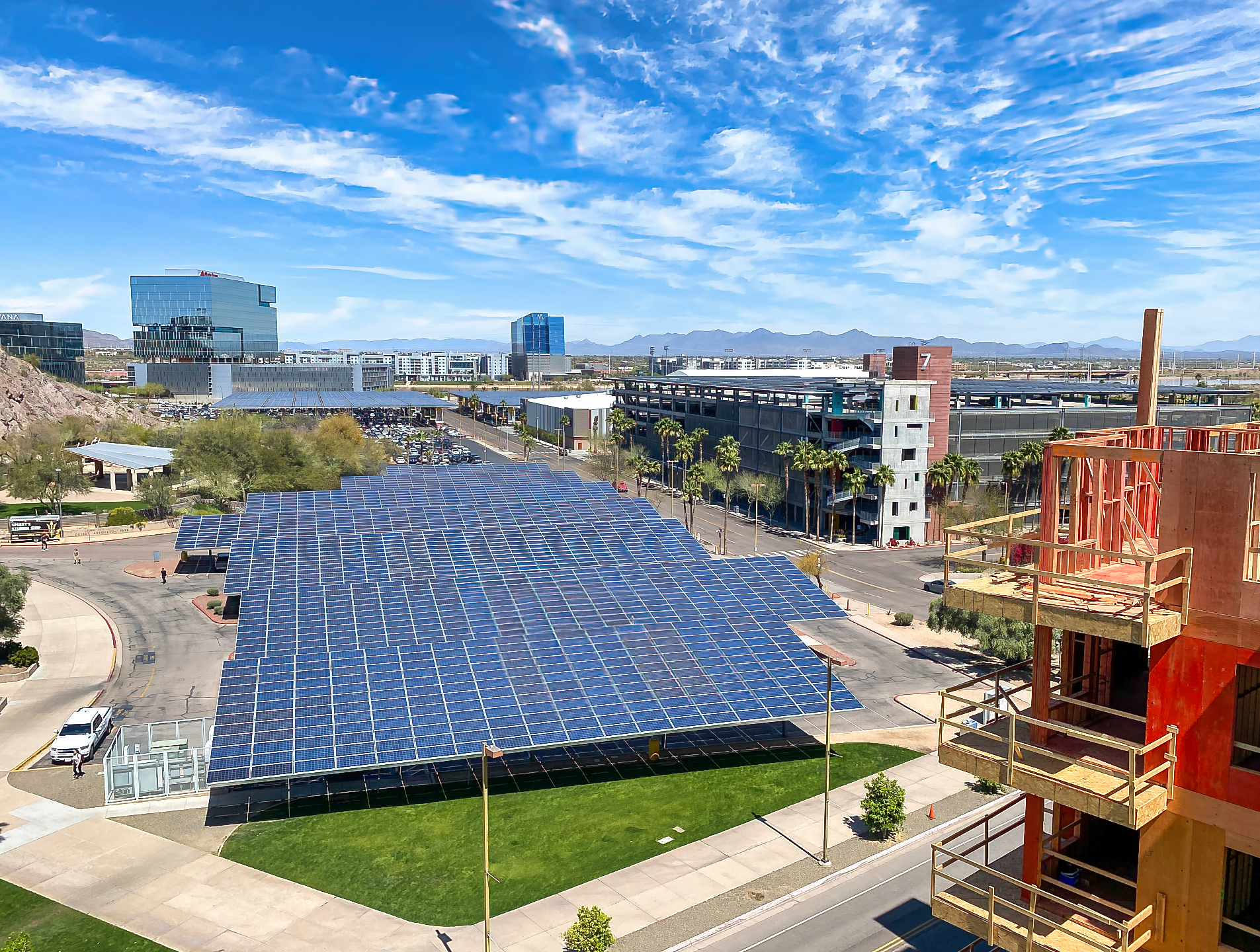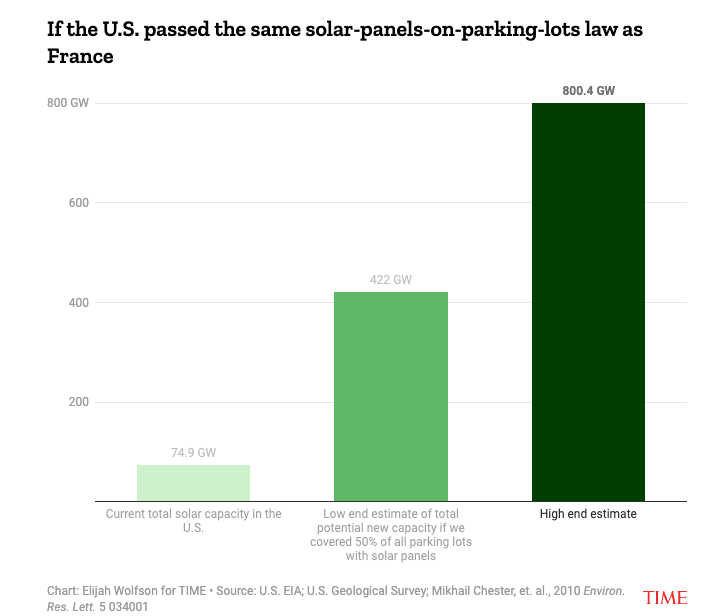Calling on the state’s utilities to provide 100% renewable energy by 2050, Virginia’s Clean Economy Act presents an exciting framework for a mix of renewable energy solutions for the Commonwealth. Rapidly decreasing solar and battery storage costs make the goal viable.
But exploding electric demand, almost entirely from data centers, is doubling the amount of electricity we need. That’s complicating and compromising our 2050 goals, because powering all that new demand is leading to big impacts on natural resources and a continued reliance on fossil fuels.
Large-scale solar, typically over five megawatts and starting at around 35-50 acres, will be a critical part of the transition to clean energy, but it has some downsides. For instance, the escalating energy demands of the data center industry in Virginia would require hundreds of thousands of acres of land for solar — at the expense of prime agricultural land and forests. Large-scale solar facilities in rural areas also require extensive transmission lines to connect to the regional power grid, with years-long wait times. In the meantime, gas and coal, with their deleterious health and climate impacts, are being tapped to fill the demand gap.

The urgency of these issues has created increased pressure points at the state and local levels, and even within the environmental community itself.
But another path to a renewable energy system exists — one that is smarter and more efficient. “Distributed solar” refers to smaller solar installations such as rooftop, brownfield and parking lot solar. Because it is placed in already-built environments, distributed solar is close to where energy is needed and has fewer negative impacts on the environment while saving households and communities money. And it employs around 10 times more people than large-scale solar.
Since Virginia is still at the beginning of its energy transition, now is the perfect time to rebuild our energy system in a way that is just and fair to all Virginia residents and ratepayers. Toward that end, PEC has taken the lead in aggressively exploring the viability of parking lot solar in Virginia.
The action-oriented leg of the journey began last summer, when Dr. Samantha Ahdoot, director of Virginia Clinicians for Climate Action, called us to discuss existing research on high mortality rates and economic losses caused by poor air quality and the ways clean energy can help. That call led to a partnership between our two organizations and connections with Virginia research institutions that could provide complex, robust mapping research on the actual production capacity of parking lot solar in Virginia.
What we found is that the Commonwealth is awash in parking lots full of potential generating capacity. In fact, according to preliminary studies by one of our partners, parking lot solar facilities could generate around half of Virginia’s energy usage! And parking lot solar enjoys the benefits of distributed solar that large-scale solar lacks.
Because it’s installed in the built environment, parking lot solar preserves prime agricultural soils and forests, which have their own environmental benefits. Forests sequester carbon from the atmosphere, filter pollutants from groundwater and contribute to healthy ecosystems. Prime agricultural soils contribute to local rural economies and aid in regional food security, an important benefit that rose in the public awareness during the supply chain breakdowns of the recent global pandemic.
Parking lot solar is also a more efficient use of land, since it generates one megawatt of energy for every two acres, as compared to large-scale solar’s one megawatt of energy per seven-to-10-acre average. And by keeping cars cooler on warm days, the shade provided by these solar canopies reduces the energy and emissions needed for air conditioning.
When adopted broadly, parking lot solar would feed excess energy directly into the distribution grid, getting clean energy on the grid more quickly, and collectively reducing the need for more hulking steel-girded towers that occupy 500-foot rights of way beneath them. That means getting cleaner energy — and cleaner air — to replace carbon-emitting sources faster.
This investment in places where people already work and live is not only good energy policy, it is good economics and smart growth that respects our natural and cultural resources.
Some places near and far have already taken initial steps in implementing parking lot solar. France has mandated that 50% of large parking lots be covered with parking lot solar. Closer to home, large canopies are showing up in places like New Jersey, New York and even Washington D.C. In fact, D.C. Metro is currently implementing four large-scale parking lot solar projects on their station site parking decks.

Why aren’t we seeing parking lot solar here in the Commonwealth then? The answer is simple: it’s just not as profitable for solar developers and investors. Based on the current incentive structure, or lack thereof, removing forest and farmland for solar is cheaper for solar developers than placing it on a parking lot. But if we financially accounted for the negative externalities of large-scale solar, such as stormwater runoff and loss of farmland and forest lands, that cost differential would look quite different.
After extensive research and conversations with large developers and clean energy financiers, it became clear to us that an incentive based on Solar Renewable Energy Certificates (SRECs) would be effective in closing the cost difference for parking-lot solar. SRECs are solar incentives that allow developers to earn additional income for each megawatt-hour of energy produced, and buying SRECs are one mechanism through which Virginia utilities fulfill their annual clean energy obligations. An incentive linked to SRECs has proven efficacy elsewhere and would reflect and magnify Virginia’s renewable energy priorities.
Led by our research, during the 2024 legislative session PEC authored a legislative proposal for a parking lot solar pilot program in the Commonwealth. Our proposal included a SREC incentive, a stakeholder process to determine the optimal incentive level and a mapping process to determine ideal sites. The resulting bills, SB234 and HB367, were sponsored by Senator Ghazala Hashmi and Delegate David Reid.
During the first major Senate committee hearing on the Parking Lot Solar Development Pilot Grant Program, PEC’s expert technical testimony was followed by supporting testimony from an inspiring set of partners, including Virginia Farm Bureau, Virginia Agribusiness, Southern Environmental Law Center, Virginia League of Conservation Voters, Climate Cabinet, Virginia Conservation Network, Natural Resources Defense Council and Virginia Cattlemen’s Association.
The bill moved on to the Finance Committee and eventually passed the Senate with a strong 30-10 bipartisan floor vote. While a House appropriations subcommittee eventually carried the bill over to 2025, we were able to secure robust funding through the recently approved state budget. Just as importantly, at a time of great division across both the state and the nation, we were deeply encouraged by the support from a wide range of stakeholders who saw their own values reflected in the prospect of strong parking lot solar implementation throughout Virginia.
Part of PEC’s vision for the Virginia Piedmont, and even beyond, is that residents and leaders of all walks of life and world views act on a belief that conserved lands are essential to vibrant, healthy communities. That means taking a thoughtful and holistic approach to tough issues, like the clean energy transition, and looking out for unintended consequences and on-the-ground impacts.
Our hope for a strong parking lot solar initiative in Virginia keeps an eye on preserving the environmental benefits of undeveloped lands and food security in our region, while also connecting clean energy quickly to the grid for its public health and global climate benefits. Creating parking lot solar research, support, legislation and funding is just the first step in expanding support for distributed generation and tapping into the motivations of diverse communities to deliver practical solutions for Virginia’s clean energy future.
This article appeared in the 2024 summer edition of The Piedmont Environmental Council’s member newsletter, The Piedmont View. If you’d like to become a PEC member or renew your membership, please visit pecva.org/join.
